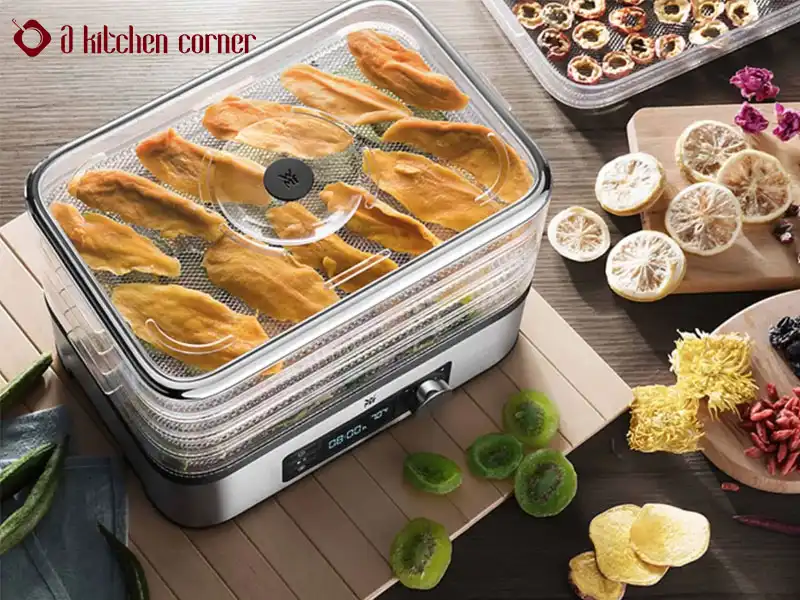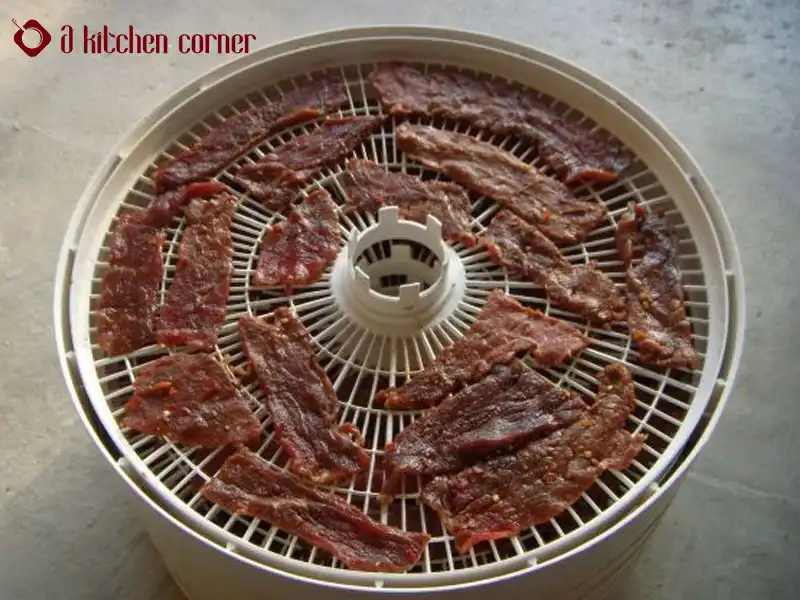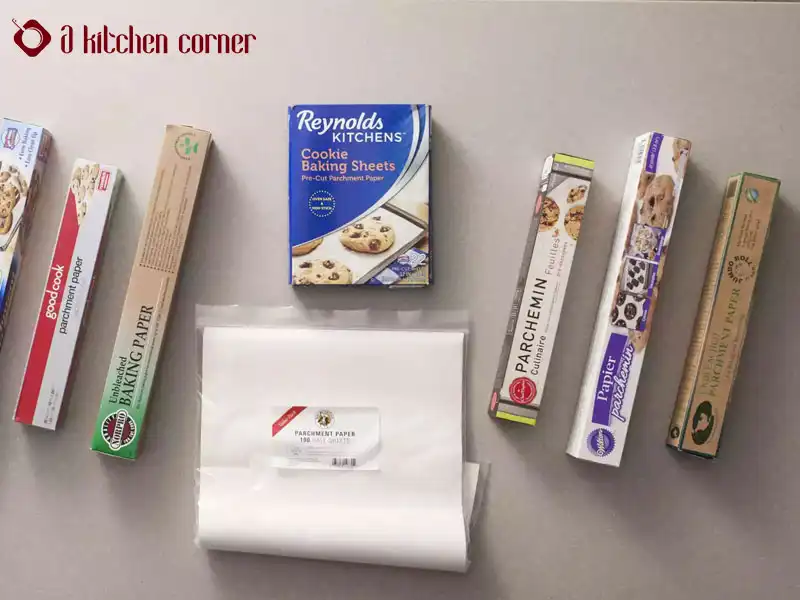Dehydrating Food Safely: Can You Leave a Dehydrator on Overnight?

Are you a fan of dehydrated foods and wondering if can you leave a dehydrator on overnight? You’re not alone! Many people have concerns about the safety of leaving appliances on overnight, especially those that generate heat.
In this blog, we’ll explore the topic of leaving a dehydrator on overnight and provide you with some essential safety tips to ensure you can enjoy your dehydrated foods without any worries. Let’s dive in!
Contents
Can You Leave a Dehydrator On Overnight?
Yes! you can leave your dehydrator on overnight without any risk. Just be sure to follow the recommended drying techniques and safety precautions to prevent overdrying your food. Dehydrators are made to run for longer than 12 hours. Furthermore, some dehydrators feature timers that automatically switch them off, allowing you to relax.
Nevertheless, dehydrators, like any electrical device, should always be of good quality. Cheaper models may have damaged wiring and other attachments, which can lead to heat buildup inside the dehydrators and create a fire risk. The dehydrator from Cosori has been our all-time favorite thus far.
Is It Safe to Leave a Dehydrator On Overnight?
After learning that you may keep your dehydrator on overnight, you might wonder if doing so is safe. This is all you need to know.
Because of their construction, dehydrators can run continuously for up to three days or more. You must run your dehydrators since certain fruits require 24 to 36 hours to completely dry. So that, you can leave them on all night long.
>> Related post: What Is a Dehydrator? How Does a Dehydrator Work?
Additionally, people who leave in the morning and return in the evening will benefit from leaving it on overnight. I would much rather have it on at night when I’m around than during the day when I’m not.

You can leave your dehydrator on overnight.
Some Safety Tips For Dehydrator
Electrical appliances, including the dehydrator, are fire dangers, therefore use them with the utmost caution. Here are some safety guidelines for food drying.
- Periodically check for faulty or damaged parts. When your dehydrator develops a problem, bring it to the closest authorized service center for repair or inspection. Additionally, be sure that the repair facility only employs accessories and parts that came from the factory.
- Disconnect the appliance from the power source, before doing maintenance, changing accessories, or cleaning
- Make sure it is stable while operating the process. To prevent movement while operating, all four feet need to be securely planted on a flat surface.
- Dehydrators should never be used near anything flammable or combustible. Additionally, keep them strictly indoors and only use them when there is adequate airflow.
- To reduce the likelihood of electrocution, make sure your dehydrator is completely dry after cleaning before turning it on.
- You run the risk of receiving an electrical shock if you modify the electrical plug.
How Long Does It Take to Dehydrate Different Foods?
Meat
After preheating your dehydrator to 160°F for meat, leave the temperature there for 6–12 hours, or until the meat is firm. These are explanations
- To keep the food from rotting, the dehydration process must go quickly enough.
- It must remove water from the environment at a rate that prevents the growth of germs.
>> Related post: How to dehydrate meat for jerky? A beginner’s guide to making jerky at home

Turkey and chicken
First, preheat/cook the chicken at 165°F to kill some microorganisms that can withstand high heat. Then, put it out in your dehydrator and dry it entirely for 6 to 12 hours at a temperature of 145°F.
- The relative humidity in your room.
- The temperature of the poultry before it started to dehydrate.
- The food supply.
- How lean your meat is.
On occasion, you might need to blot fat splatters off the surface of your poultry.
Fruits
First, arrange the fruits on dehydration trays in a single layer and preheat your dehydrators to 135 to 145°F.
The drying times for fruits including nectarines, apples, peaches, and bananas range from 6 to 16 hours. Fruits like figs, grapes, pears, and apricots keep longer and can dry completely in 20 to 36 hours.
Fruits will become leathery when they have completely dried out.
Vegetables
Vegetables should be dried at a temperature of 125°F to prevent burning. As a result, depending on the vegetable, dehydrator grade, load size, ambient humidity, etc., dehydration can take anywhere between 4 and 13 hours.
Grains
All grains, including rice, should be dehydrated at 145°F for 6 to 12 hours, or until you feel they are totally dry. It has been falsely claimed by a number of online sources that you may dehydrate grains at temperatures as low as 125°F. Lower than 135°F, bacteria like Bacillus cereus can thrive.
Pasta
Pasta is dried out and made brittle by dehydrating it at 135°F for 6 to 12 hours. Spread it evenly on your dehydrator tray as well to reduce the layer thickness.
Lentils and beans
Beans and lentils should be dehydrated at 125°F for 6 to 12 hours, or until they feel hard to the touch. And unlike canned beans, home-pressure-cooked beans don’t dehydrate as quickly. However, lentils and beans both dehydrate and rehydrate efficiently.
Frequently asked questions – Can You Leave a Dehydrator on Overnight?
The optimal dehydrator setting is a low temperature if you intend to use it overnight.
This will enable the dehydration process to proceed quite rapidly while preserving the flavor and color of your dried fruit.
Most dehydrators let you choose the temperature between 40 and 45 degrees, this is a great temperature range to shoot for because.
If you wish to hasten the drying process, you could also want to think about using a little higher temperature setting, though doing so might cause some flavor and color to be lost.
Yes! Due to a number of circumstances, they can quickly overheat and catch fire. These consist of:
- The heating element is broken
- Defective or broken fan blades
- You might be packing your batches too lightly.
Therefore, make sure all of the components are functional before utilizing a dehydrator. Examine the moving components, such as fans, for alignment and binding problems as well.
The air vents on the back of your dehydrator should not be blocked because they are crucial for the passage of heat and air.
If these air vents are blocked, the temperature may increase too much and start a fire. Keep your dehydrator at least 6 inches (15 cm) away from the wall as a result.
Dehydrators are incredibly energy-efficient and may be purchased at a reasonable price.
The majority of large dehydrators utilize one kWh or less per hour. Dehydrators can therefore be run very cheaply, even overnight.
The price of a dehydrator varies according to its size and duration of use. Regardless, dehydrators are inexpensive and can be a helpful appliance for preserving food at home.
The goal of drying food is to minimize bacterial development by removing as much water as possible. As a result, drying food in the dehydrator for a long time causes it to become inedible.
The food can become too hard before it is fully dried when it is overdried, which also depletes the food of nutrients and can cause hardness.
The hard surface prevents the fruit’s inside from releasing moisture, which can lead to mold growth while the fruit is being stored.
Some do turn off automatically, while others do not. Dehydrators include various safety and convenience features that vary from one model or make to another, just like any electrical device at home or at work. In other words, you get what you paid for.
There are several foods that you shouldn’t dehydrate for a long time for a variety of reasons, including to avoid denaturation and vitamin or mineral content destruction.
- Vegetable.
- Hard fruits.
- Herbs.
- Grain raw.
- Salads.
Conclusion
To sum it up if you’re wondering if can you leave a dehydrator on overnight, the answer is yes!
However, it’s crucial to follow the manufacturer’s instructions and take necessary safety measures, such as keeping the dehydrator away from combustible materials, monitoring the drying process, and avoiding overloading the appliance.
By doing so, you can safely and efficiently dehydrate a wide variety of foods to enjoy their benefits, including longer shelf life, intensified flavors, and retained nutrients.
Remember to follow the recommended temperature and time settings for different types of food and remove them once they reach the desired texture.
With these key points in mind, you can confidently use your dehydrator to create healthy and delicious snacks and meals.
You might be interested:








